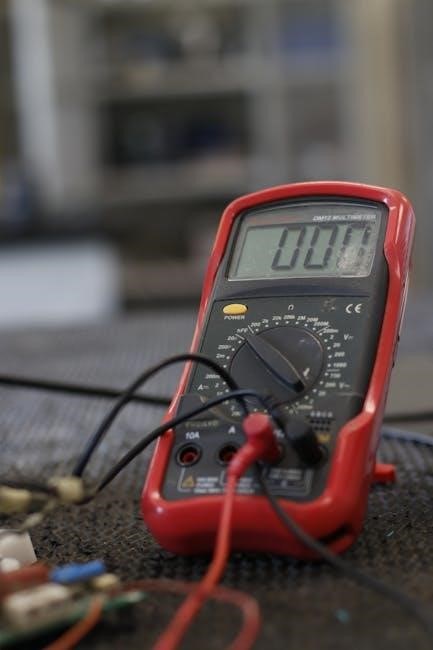The Iceman Ice Machine is a portable, countertop ice maker designed for convenience and efficiency. It produces fresh ice in under 10 minutes, offering dual-size ice cubes for versatility. Compact and easy to use, it’s perfect for home, office, or outdoor settings.
1.1 Overview of the Iceman Ice Machine
The Iceman Ice Machine is a portable, countertop ice maker designed to provide quick and efficient ice production for home, office, or outdoor use. It features dual-size ice cube capability, allowing users to choose between small and large cubes to suit their needs. The machine is compact and lightweight, making it easy to transport and place on any flat surface. With an attachable handle, it offers added portability for convenience. The Iceman Ice Machine is equipped with a water tank and an ice basket, and it can produce a batch of ice in less than 10 minutes. Its user-friendly design and straightforward operation make it an ideal solution for anyone needing a reliable ice-making solution without the hassle of complex setup or maintenance.
1.2 Importance of Following Instructions
Following the instructions for the Iceman Ice Machine is crucial for safe and efficient operation. Proper setup and usage ensure optimal performance, preventing damage to the machine and avoiding potential safety hazards. Instructions guide users on correct water levels, ice size selection, and maintenance routines, which are essential for longevity. Failure to adhere to guidelines may result in inadequate ice production, machine malfunction, or electrical issues. Additionally, instructions provide troubleshooting tips to address common problems, minimizing downtime and extending the product’s lifespan. By adhering to the provided directions, users can enjoy consistent ice production while maintaining safety and efficiency. Regular cleaning and descaling, as outlined in the instructions, prevent mineral buildup and ensure the machine remains in good working condition. Always refer to the manual for specific guidance tailored to the Iceman Ice Machine model to maximize its functionality and durability.

Safety Instructions
Always place the Iceman Ice Machine on a hard, level surface, away from children and hot water sources. Ensure proper electrical connections and avoid overloading outlets to prevent hazards. Follow manual guidelines for safe operation.
2.1 General Safety Precautions
To ensure safe operation of the Iceman Ice Machine, always place it on a hard, level surface away from direct sunlight and hot water sources. Keep children away from the machine to avoid accidental injuries. Before use, confirm the drain plug is securely closed to prevent water spills. Avoid overloading electrical outlets, as this can pose fire hazards. Regularly inspect the power cord and plug for damage, and refrain from using the machine if any components are worn or faulty. Never submerge the unit in water or expose it to extreme temperatures. Follow the manufacturer’s guidelines for electrical connections and avoid modifying the machine. Proper usage and adherence to these precautions will help maintain safety and extend the lifespan of your Iceman Ice Machine.
2.2 Proper Placement and Installation
Proper placement and installation of the Iceman Ice Machine are crucial for optimal performance and safety. Position the machine on a hard, level surface to ensure stability and even ice production. Avoid placing it near direct sunlight or hot water sources, as this can affect efficiency. Ensure the drain plug is securely closed before use to prevent water spills. Place the machine away from children to avoid accidental tampering. For outdoor use, ensure the surface is flat and protected from extreme weather conditions. If moving the machine, always unplug it first to prevent damage. Proper installation also involves ensuring the machine is not overloaded with water and that the ice basket is correctly aligned. Regularly check the drain plug before each use to ensure it is firmly in place. Following these guidelines will ensure smooth operation and longevity of your Iceman Ice Machine.
2.3 Electrical Safety Guidelines
To ensure safe operation, always follow the electrical safety guidelines for the Iceman Ice Machine. Plug the machine directly into a grounded electrical outlet rated for its power requirements. Avoid using extension cords or overloaded circuits, as this can cause electrical hazards. Keep the machine away from water sources to prevent accidental exposure, which could lead to electrical shock. Never submerge the machine in water or operate it in wet conditions. Ensure the power cord is not damaged or frayed, as this could pose a fire risk. If the machine malfunctions, unplug it immediately and contact customer support. Do not attempt to repair the machine yourself. Keep children away from the electrical components to avoid accidental injury. Always unplug the machine when not in use or during cleaning to maintain safety. Following these guidelines will help prevent electrical accidents and ensure the longevity of your Iceman Ice Machine.

Features of the Iceman Ice Machine
The Iceman Ice Machine features dual-size ice making, producing both small and large cubes. Its portable, compact design makes it ideal for countertops, while its rapid ice production ensures fresh ice in under 10 minutes.
3.1 Dual-Size Ice Making Capability
The Iceman Ice Machine offers a convenient dual-size ice making feature, allowing users to produce both small and large ice cubes. This versatility caters to various needs, whether for beverages, cooling, or preserving. Small ice cubes are ideal for drinks, while larger cubes are better for cooling or preserving items. The machine’s intuitive controls enable easy selection of the desired ice size. With a production cycle of under 10 minutes, users can enjoy fresh ice promptly. This feature enhances the machine’s adaptability for different settings, from home use to outdoor gatherings. The dual-size capability ensures that the Iceman Ice Machine meets a wide range of user preferences and requirements efficiently.
3.2 Portable and Compact Design
The Iceman Ice Machine features a sleek, portable, and compact design, making it easy to move and place in various settings. Its lightweight construction and attachable handle provide added convenience for transportation. Perfect for small kitchens, offices, or outdoor gatherings, this machine fits seamlessly into any space. The compact dimensions ensure it doesn’t occupy too much countertop area, while its modern design complements most home or office décors. Whether you’re hosting a party, camping, or relaxing on a boat, the Iceman Ice Machine’s portability ensures fresh ice is always within reach. Its design prioritizes user convenience, allowing effortless relocation without compromising on performance. This makes it an ideal choice for those who value flexibility and ease of use in their ice-making solutions.

Operating Instructions
Fill the water tank, select your preferred ice size, and press start. The machine begins making ice in under 10 minutes. Monitor progress through the transparent lid and dispense ice as needed for convenience.
4.1 Initial Setup and Preparation
Before first use, unbox and inspect the Iceman Ice Machine for any damage. Ensure the drain plug is securely closed. Place the machine on a stable, level surface away from direct sunlight and moisture. Plug in the power cord, ensuring it’s connected to a grounded outlet. Allow the machine to cool down for 5 minutes before adding water. This preparation ensures optimal performance and extends the machine’s lifespan. Always follow these steps to guarantee safe and efficient operation.
4.2 Adding Water and Ice
Before operating, ensure the drain plug is closed and the machine is on a level surface. Fill the water tank with fresh, cold water to the marked fill line. Do not use hot water, as it may damage the machine. For optimal performance, add ice to the tank if needed, but avoid overfilling. The machine is designed to automatically detect water levels and start the ice-making process once properly set up. Always use clean, filtered water to ensure the quality of the ice produced. If adding ice, make sure it does not exceed the recommended level to allow proper water circulation. Properly securing the water tank and ice basket ensures smooth operation and prevents spills. Follow these steps to ensure efficient ice production and maintain the machine’s functionality. Always refer to the fill line indicators to avoid overfilling, which can lead to operational issues. This step is crucial for achieving the best results from your Iceman Ice Machine.
4.3 Selecting Ice Size and Starting the Machine
Once the machine is prepared with water, you can select the desired ice size using the control panel. Most models offer dual-size options, typically small or large cubes. Press the SELECT button to choose your preferred size, and the corresponding indicator light will illuminate to confirm your selection. After selecting the size, press the START button to begin the ice-making process. The machine will automatically start once the water has reached the optimal temperature, usually around 50°F. You can expect the first batch of ice to be ready in approximately 5-10 minutes, depending on the model and environmental conditions. The machine will continue to produce ice until the ice basket is full or the water tank is empty. Always ensure the machine is properly assembled and all components are securely in place before starting. This ensures safe and efficient operation. Regularly checking the water level and ice basket during operation helps maintain performance and prevents interruptions.
4.4 Dispensing Ice
Once the ice basket is filled with freshly made ice, you can easily dispense it for use. To dispense ice, press a cup or container against the dispensing trigger located on the front of the machine. The trigger releases the ice cubes into your cup. Ensure the cup is large enough to hold the ice cubes to avoid spills. Ice can typically be dispensed as soon as the first batch is ready, usually within 5-10 minutes of starting the machine. For optimal performance, do not overfill the ice basket, as this may cause jamming. Regularly monitor the ice basket level to ensure smooth dispensing. If the machine stops producing ice, check the water level in the tank and refill if necessary; Always handle the ice basket and cubes with care to avoid accidental spills or damage to the machine. Proper dispensing ensures efficient operation and maintains the longevity of your Iceman Ice Machine.
Cleaning and Maintenance
Regularly clean the Iceman Ice Machine to prevent bacterial growth and mineral buildup. Wipe surfaces with a soft cloth and descale every 3-6 months. Dry thoroughly after cleaning to maintain performance and longevity.
5.1 Regular Cleaning Procedures
Regular cleaning is essential to maintain the performance and hygiene of your Iceman Ice Machine. Start by turning off and unplugging the machine. Remove the ice basket and wash it with mild soap and warm water. Wipe the interior and exterior surfaces with a soft, damp cloth to prevent mineral buildup. For tougher stains, mix a solution of equal parts water and white vinegar and apply it to the affected areas. Let it sit for 10 minutes before rinsing thoroughly. Clean the water reservoir by draining it completely and refilling it with fresh water. Repeat this process if you notice any sediment or odors. Descaling every 3-6 months is also recommended to remove mineral deposits. Use a descaling solution or a mixture of water and lemon juice, following the manufacturer’s instructions. After cleaning, dry all parts with a clean towel to prevent moisture buildup.
5.2 Descaling and Preventing Mineral Buildup
Descaling your Iceman Ice Machine is crucial to prevent mineral buildup from hard water, which can affect performance and ice quality. Over time, minerals like calcium and lime can accumulate inside the machine, reducing efficiency and potentially causing damage. To descale, mix a solution of water and descaling agent (or white vinegar) as per the manufacturer’s instructions. Pour the solution into the water reservoir and run an ice-making cycle to allow it to circulate through the system. After completing the cycle, rinse the machine thoroughly by running a few cycles with fresh water to remove any residual solution. For prevention, use distilled or filtered water if you live in an area with hard water. Regular descaling every 3-6 months will keep your machine in optimal condition and extend its lifespan.
5.3 Storing the Machine Properly
Proper storage of the Iceman Ice Machine is essential to maintain its functionality and longevity. When not in use, ensure the machine is completely dry to prevent mold or mildew growth. Drain all water from the reservoir and ice basket, and wipe down the interior and exterior with a clean, dry cloth. For extended storage, consider covering the machine to protect it from dust. Store it in an upright position to avoid any residual water from seeping into internal components. Avoid placing the machine in extreme temperatures, such as direct sunlight or freezing environments. Before storing, ensure all parts are clean and free of mineral buildup. If storing for an extended period, check the machine for any damage or wear upon removal. Proper storage will ensure your Iceman Ice Machine remains ready for use whenever you need it.

Troubleshooting/FAQs
Common issues include the machine not producing ice, often due to low water levels or improper settings. Check the power connection and ensure the ice size is selected correctly for optimal performance.
6.1 Common Issues and Solutions
One common issue is the machine not producing ice, often due to low water levels or improper ice size selection. Ensure the water tank is filled to the recommended level and the ice size button is pressed correctly. If the machine is noisy, check for misaligned ice trays or loose components. Another issue is water leaks, which can occur if the drain plug is not securely closed. Verify the drain plug is tightly sealed and the machine is placed on a level surface. If the ice maker stops mid-cycle, unplug it, let it reset, and restart. For mineral buildup, descale the machine regularly using a vinegar solution. Always refer to the user manual for specific troubleshooting steps to maintain optimal performance and extend the machine’s lifespan.
6.2 Frequently Asked Questions
Q: How long does it take to make a batch of ice?
A: The Iceman Ice Machine produces a batch of ice in less than 10 minutes, making it ideal for quick refreshment needs.
Q: Can I move the machine while it’s operating?
A: No, it’s recommended to keep the machine stationary during operation to ensure proper function and avoid spills.
Q: Why is my machine making noise?
A: Noise may occur due to misaligned ice trays or uneven surfaces. Check and adjust the trays, and ensure the machine is placed on a level surface.
Q: How do I prevent mineral buildup?
A: Regular descaling with a vinegar solution helps prevent mineral deposits and maintains performance.
Q: Can I use hot water in the machine?
A: No, using hot water can damage the machine. Always use cold water for optimal results.
Q: Is the machine portable?
A: Yes, the Iceman Ice Machine is lightweight and comes with an attachable handle, making it easy to transport.
Q: How often should I clean the machine?
A: Clean the machine regularly after each use to prevent mold and bacteria growth, ensuring hygiene and longevity.

Warranty and Support
The Iceman Ice Machine is backed by a limited warranty that covers defects in materials and workmanship for a specified period from the date of purchase. The warranty typically includes coverage for parts and labor, ensuring your machine operates efficiently. To activate the warranty, register your product on the manufacturer’s website or complete the registration card included in the packaging.
For any inquiries or issues, the dedicated customer support team is available to assist. You can contact them via phone or email, as listed in the user manual. Additionally, the manufacturer provides online resources, including FAQs, troubleshooting guides, and downloadable manuals, to help resolve common concerns.
In case of warranty claims, retain your purchase receipt and follow the instructions provided by the support team. The warranty does not cover damage caused by misuse, improper maintenance, or unauthorized repairs.




















































